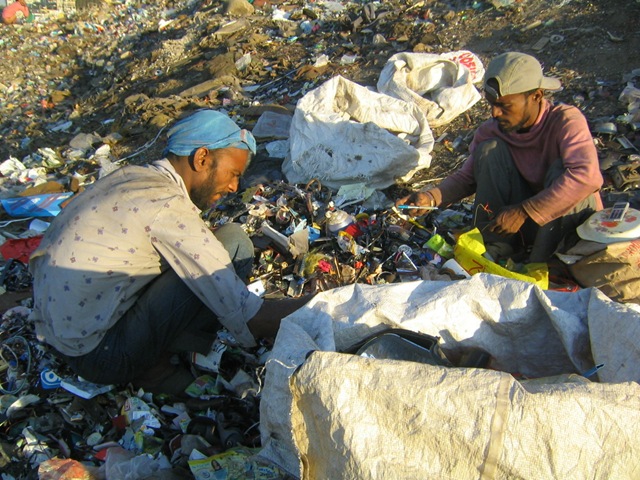The article below is from Livemint.com and the original piece can be found at: http://www.livemint.com/2010/10/29181935/Recycling-and-respect.html

Few neighbourhoods in Mumbai have attracted global attention the way Dharavi has. But all the intense, often glamorized focus on the area can misrepresent it. It is justly described as a hub of enterprise, evidence that even the most disadvantaged of urban populations can thrive in spite of adversity.
But celebrating that can-do spirit and the common humanity that visitors and tourists love to identify with, can sometimes obscure Dharavi’s realities.
It can be one of the most hostile working environments in the city, and perhaps no population confronts its risks more directly than its waste collectors, commonly called ragpickers, the base of Dharavi’s growing recycling industry.
“I used to pick and sort plastic all day, too,” says Lakshmi Kamble, 30. “My life was about that. I wanted to be a doctor when I was a child, but we couldn’t afford it. And my whole life, as I grew up in Dharavi, got married, became a mother, got divorced, and moved back here with my daughter—I had no identity of my own.” She was sorting plastic the day she first heard of ACORN India’s Dharavi Project. “I thought to myself, what good would this do me? What was the point of being part of such a project?”
ACORN India, affiliated with ACORN International, is a registered charitable trust currently working in Mumbai, Delhi and Bangalore, focused, in their own words, on four Rs.: “Reduce, Recycle, Reuse and Respect”. The Dharavi Project, which began operations in August 2008, is a participative resource for the communities which form part of the area’s recycling industry. At its heart is a collective that aims to give ragpickers the tools and training to improve their working conditions. Handling toxic materials and the rotten by-products of Mumbai’s industries poses significant health hazards to those who collect and sort them on punishing schedules, seven days a week. The project also aims to give the community the credit they deserve as essential workers in a city whose waste output keeps pace with its rate of growth. They are also faced with a near-total lack of respect and social security, bereft, as Lakshmi says, of any identity beyond that of the unclean and the hopeless.
According to ACORN India, 40% of this unacknowledged workforce consists of women and children: a population that can face exceptional risks and exceptional pressures from their families. Take Lakshmi’s daughter Sheetal, for instance: She used to be teased by others at the local municipal school for having a mother who picked up garbage. Lakshmi says she has heard the same about her own mother—like her, a native of Dharavi and a plastic collector.
“When I came to ACORN, I got my own bearings first,” she says. “I asked myself questions about the work I had been doing all my life. Is it good or bad? I told myself that as unclean or dirty as the job might be, I am doing a good thing. I am taking a load off the BMC (Brihanmumbai Municipal Corporation). Why should I feel ashamed of what I am doing? I explained this to my daughter: Tell those who tease her, so what if my mother does this? She doesn’t have to depend on anyone else to feed me. It put my daughter in the right frame of mind too.”
Today, Sheetal, 11, spends her time outside school in the variety of activities the Dharavi Project organizes for the children of its members. Some of those children—not Sheetal—are ragpickers themselves, compelled by hunger and family pressure to earn money. Through music, sport, dance and art, the Dharavi Project aims to give the community’s children some much-needed recreational space, and allow them to think about alternatives to their future. It has just ended a successful music workshop, and is running a football programme for the children right now.
Watching Sheetal run around on the grass with other girls, Lakshmi says: “The children don’t always come here knowing right from wrong. Some of them felt they only had to earn money, by good means or bad. Some of them committed crimes. But today I feel like these children are learning to create an identity for themselves. If they play games together, then maybe tomorrow they will have what it takes to form teams, to take part in competitions, to stand up to the world outside. They will learn that hard work will actually make a difference in their lives.”
Lakshmi’s mother Hanumanthi too attends the Dharavi Project’s programmes on the big days. “I’m too busy to go along to all their activities,” she says gruffly, but smiles as she recalls Sheetal’s participation in dramas, dance and singing. She is the head of the family as far as Lakshmi is concerned—out of their extended circle of kith and kin, she is the first of the three Kamble women who form the family that Lakshmi values. “My mother is my inspiration,” Lakshmi says. “The values I pass on to the others who come to ACORN India, especially the children, are the ones she gave me.”
Lakshmi is one of the Dharavi Project’s committee members today, organizing the community in rights-based work, training the collectors with whom she works side by side during the day, and ensuring that the other children in the project get the support and guidance they require from their own parents. “We have a chance to give these children the things we have never had,” she explains. It is not easy being a member: She typically divides her day between work, taking care of Sheetal, housekeeping, and ACORN India’s office, where she started to volunteer in March 2009 out of a sense of purpose, and which has become a passion and unpaid vocation.
“My mother was annoyed by what she considered a waste of time at first,” Lakshmi admits. “But now she has come around to the idea. She realizes that even if I earn less money because of the time I give to ACORN, people will know who she is one day: because of her daughter and the work she does.


